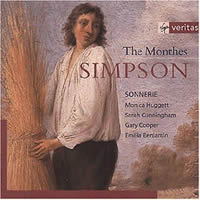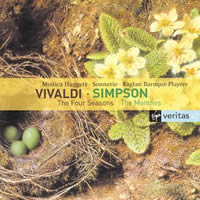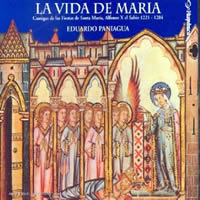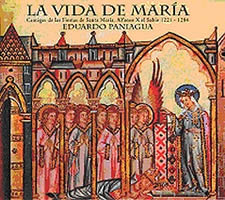Kipple 4.
|
Bart Scribner [November 2005.] Tower Records had original issues of these in the cutout bin but repackagings are already in place, so word-spilling seems justified.
Christopher SIMPSON: The Monthes, 12 Fantasias; Ground in A minor; in B-flat major; Suite in D major. Sonnerie. Virgin Veritas 5621612 (twofer offering with The Four Seasons and other Vivaldi concertos) (http://www.virginclassics.com/). Simpson (c. 1605-1669) is recalled as the primary booster of divisions, a method for extemporizing variations over a ground bass. (Notes of the source are divided into smaller units of the player’s invention.) He wrote a pair of important music tutorials — The Division-Violist (1659), The Principles of Practical Musick (1665) — and the examples in those books, some quite beautiful, are the only music he published. Decades later, Purcell called Principles’ second edition “the most Ingenious Book I e’er met with upon this Subject.” Fortunately Simpson circulated his scores in manuscript, and the 12 fantasias titled The Monthes (1659 or earlier, to judge by John Jenkins’ approving verse) are top-drawer — noble, creative pieces best enjoyed, not chattered about. At 5:08, January is the longest of the group and its layout can more or less stand for the rest. Brief, contrasting episodes impart energy and tension — no chromatism à la Dowland, Lawes, Locke, et al. A slowly seesawing violin lead is augmented in turn by organ, viol and second violin to fill out a busy texture (“answering One Another … and sometimes, All joyning Together in Division”). A swell announces drawn-out music with close imitation — the sound of the Elizabethan viol consort. This gives way to sparkling dance figures, then to stacked unison as the viol heads a striking variant on choral part-writing. From here the violin steps forward to deliver the stirring coda (“But commonly, Ending in Grave, and Harmonious Musick”). The glories of England’s viol-consort repertory (the most profound chamber genre prior to the string quartet) were inner-directed, aimed at the edification of the ensemble’s players. Simpson’s way of loosening that formal rigor took an audience into account, but would have a short life. By the mid-1670s, Nicola Matteis and other violin virtuosi from abroad pointed a new (less demanding, let it be said) direction, leaving Simpson looking conventional and unexciting. After numbers 3, 6 and 9, Sonnerie inserts samples of Simpson’s teaching. The grounds are intended for study by those wanting to cultivate skill at division-playing. The A-minor one is for equal bass instruments; here organ and viol hand the ground and improviser roles back and forth, between producing the subject or skipping and dancing freely. A simpler setup guides the B-flat major (“for the practise of Learners”), as rapid viol passagework lifts off from the organ’s stately declamation. The Suite collects a series of Ayres, so it lacks The Monthes’ brilliant strokes. Still, the unison sections and bursts of activity are quality Simpson. Sonnerie was Trio Sonnerie until the addition of second violinist Emilia Benjamin. Its experience on this seldom-trod turf is considerable; A Gift of Nature (Simpson’s term for divisions talent) surveyed the landscape, on Teldec Das Alte Werk 4509-90841-2. Violinist Monica Huggett is primus inter pares, unfailingly agile and alert, and Sarah Cunningham handles all of Simpson’s demands on the viol with high aplomb. (I hope the latter’s fine annotations survive in the reissue.) Gary Cooper’s chamber-organ continuo is perhaps a Simpson first — realized from chords, which would be standard practice in the Baroque. (Earlier viol consorts by Lawes and Jenkins featured keyboard parts, but they were wholly written out.) Another Simpson cycle of interest is The Seasons — four Fantasia-Ayre-Galliard suites of around 15 minutes each. Les Voix Humaines put them on a 2000 disc I haven’t heard, ATMA ACD22182. And last month Alpha released The Seasons, The Monthes and other divisions [heh heh] of Time (088), the first of two CDs including both sets and smaller works. With the label’s splendid production, a happy event — except that Sophie Watillon, the Belgian violist / leader, passed away early in September after an illness. She was 39.
“La Vida de María.” ALFONSO X “EL SABIO”: Cantigas de Santa María (1270-82), excerpts. Musica Antigua, Eduardo Paniagua (dir.). Pneuma PN2-610 (2 CDs) (http://www.ctv.es/USERS/pneuma/). Eduardo Paniagua founded Musica Antigua and the Pneuma label a decade ago to record all 400+ of Alfonso’s Cantigas. As with Harnoncourt / Leonhardt’s 1971-85 run of Bach sacred cantatas for Teldec, it’s possible to nitpick some stylistic choices or performers, but the overall richness and sweep emerge unscathed. This two-discer was Paniagua’s initial salvo, licensed by Sony in 1996. The Spanish line now has US distribution via Forte so one can start anywhere, but this program of 21 items has its own logic. Alfonso’s court was a haven for Arab, Christian and Jewish artists and intellectuals unwelcome in other areas of Spain and France, and those colors shine from the Cantigas. If Paniagua has a bias, it’s towards the exotic; the Arab influence (mudejarism) gets plenty of attention. A related priority is the deep and wide instrumental palette, much of which can be seen in the miniatures with the songs. It’s hard to credit only six players. The winds are recorders, a battalion of flutes from the axabeba (small cane model) to the fujara (long overtone flute used by shepherds), bagpipes and an early clarinet. Families of lutes and percussion sport a definite bazaar flavor, and the marine trumpet deserves a bow — a higher-pitched, resonant foghorn. Alas, the singing has received less scrutiny. Four adult soloists are employed, along with boys in alto and soprano roles. Tenor Cesar Carazo is by far the most laudable — dead-on intonation at any tempo, and enough tools to avoid dryness (a key factor because Paniagua rightly insists on complete texts). Numbers where he’s prominent are usually highlights (see below). Paula Vega and Carla Serrano, the sopranos, are mostly acceptable until Paniagua exceeds their speed limit. I’m no friend of the countertenor breed and Luis Vicent is a weak example, with a mewing instability atop the expected hoot. The youngsters don’t amaze. The soloists / chorus pattern is well-established, but Paniagua often changes singers in midstream and moves his other lead vocalists into the choir. He isn’t fanatical about entrances and exits. That, and the absence of a well-drilled chorus, makes it tough to spot a staggering of voices from the general imprecision. A few select cuts: Disc 1, Track 1 — Star of the Day (CSM-100) Star is the best-known work of the lot (nine current versions). Paniagua bends it into a raucous instrumental for his overture. The marine trumpet’s twangy rumble opens, then añafil (long, straight Moorish trumpet), Middle East percussion, bagpipes, axabeba and lute arrive. I remember hearing the start of Harnoncourt’s 1969 Orfeo and thinking Stravinsky; Aperghis fans may be thrilled by this. Disc 1, Track 3 — Dawn of All Dawns (CSM-412) Carazo achieves alchemy with the intricate 63-line text (each of the nine stanzas ends on the word “dawn”). Without diluting the incantory push, he introduces many subtle tremors; the 16:23 passes as though in a blink. Among the spare accompaniment is a dilruba — bowed in the viola register, it has a sitar-like neck. Disc 1, Track 9 — Old Woman and Child (CSM-180) Another lengthy sequence, as the verses expand on Mary’s eight names in opposed pairs — Old Woman / Child, Mother / Maiden, Pauper / Queen, Mistress / Servant. Three sopranos (Serrano plus two boys) do the honors, with the boys en masse on refrains. Sensing they might need support, Paniagua provides a balanced band fronted by santur (large Persian zither) and Carazo’s pithy viola fills. Disc 2, Track 9 — Procession (CSM-420) Even more than on Dawn, Carazo here gives one cause to embrace the set. As the soundtrack to a devotional procession, no choral commentary is allowed. (Paniagua grasps the occasion, and summons only a trio — his own marine trumpet, the dilruba and an earthenware drum.) Six 12-line stanzas illustrate Mary’s life and importance; the tenor’s hold never relaxes during the 12:35 span. Disc 2, Track 10 — Day of Judgment (CSM-421) For this unaffected plea to Mary, Paniagua stays small. The adult sopranos are aided by just a tenor recorder and dilruba. Audiophile label MA Recordings shows several albums of mudejar Spanish material from Paniagua or associates. Last time I saluted Red Wine Audio’s lineup of battery-operated gear. Jay Fisher’s report on their Lotus preamp / power amp combo is in The Robb Report Collection for December.
[More Bart Scribner, Kipple]
[Previous Article:
Jacques Du Phly: Harpsichord Works]
|



